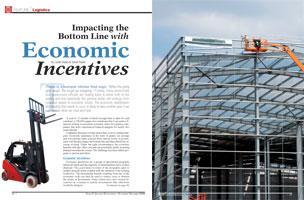

There is a bumper sticker that says, “When the going gets tough, the tough go shopping.” Frankly, many economists and government officials are hoping there is some truth to the saying and that eventually the general public will emerge from repeated waves of economic shock. The economic stabilization and healing that needs to occur is likely to take another year if we can believe what we read and hear. A year to 15 months is barely enough time to plan for, and construct, a 250,000-square-foot warehouse but it can seem a financial eternity in uncertain economic times for logistics companies that have experienced reduced margins for nearly two years already.
Companies increase revenue and reduce costs to realign margins. Economic assistance in the form of grants, tax savings and low interest loans sourced from various levels of government will directly impact the bottom line and thus effectively increase revenue. Under the right circumstances, the economic benefits will also offset cost and can potentially justify incurring planned investments sooner. The challenge becomes which program to pursue and when.
Economic Incentives
Economic incentives are a group of specialized programs which all states and the majority of municipalities have at their disposal. The good news is some of the programs cater to smaller projects when coupled with the retention of an existing workforce. The incremental benefit resulting from use of the economic tools can then be used to reduce costs or shorten the return on investment. Some clients have also viewed incentives as a means to justify investments that otherwise would be delayed.
Other incentive programs require a substantial investment and job creation to obtain access to the funds. These projects are often reported in the media, have the potential for a large bottom-line contribution, and are used to advance government’s economic strategy.
Challenges, Issues and Benefits of Economic Assistance
Throughout the rest of this article the focus will be on the challenges, issues and benefits of economic assistance which must be addressed to enable management in the logistics and warehousing industry to pursue economic incentives. A case study will be used to highlight specific points.
The biggest challenge in working with the logistics and warehousing businesses is aligning government’s perceptions with business reality. The following example is typical.
Unskilled warehouse positions are often paid a wage starting around $9.00 per hour, dependent upon location, with an increase added after a probationary period. Companies seeking economic assistance need to understand that employee wages will be compared to a standard and that the outcome of the comparison can make the difference between an enthusiastic versus a lackluster response from government. Standards vary from a county-wide average wage, to the Federal low-mod reference, or even an industry average. To make matters more challenging, the various standards can change several times in a given year. Government officials routinely seek out logistics and warehousing jobs, but their enthusiasm begins to diminish when presented with entry-level warehousing wages, even if the project represents a large number of jobs.
This is the point at which a company decides to get serious about incentives, or categorize the experience as a waste of time. If a decision is made by executives to continue the process, then the use of site competition to secure government’s attention is recommended. Site competition in these cases represents options identified and evaluated in multiple states. Certainly the time involved to secure incentive commitments under these conditions is greater but the effect of the effort usually warrants the time. The following case study is a good example of the points that have been made.
Case Study
One of our clients wanted to establish a Midwest distribution center. Based on proximity to their stores the company defined two areas, each with a 200-mile geographic radius within which they would consider eligible sites. The project encompassed consideration of facilities in four possible states (Indiana, Ohio, Kentucky or West Virginia). Proximity to an interstate highway and the need for an existing building narrowed the site selection to three states. Site visits were then arranged to evaluate potential building candidates and to discuss economic assistance with local- and state-level government officials.
The company’s average wage was well above the county average in rural areas, but compared poorly in more urban settings. In some situations, a company’s bonus plan and benefit package will be factored into the wage analysis by government. It wasn’t in this case. Even under conditions of a relatively high unemployment rate, one state hesitated to put an incentive offer together. Experience with overcoming government’s mindset and a good bit of persistence on our part achieved the desired goal of written incentive offers from all states.
The subsequent comparison and analysis of the proposed benefits, the area demographics and site specifics resulted in a clear preferred location. The ongoing benefit to the company will be in excess of $1.3 million for a multi-year investment of $10 million.
Points to Remember
It is worth noting that incentive benefits are tracked separately from revenue generated by the company and have an effective financial contribution that is greater than the number shown so it is always worth involving tax accountants once programs are committed.
It is important to remember that the majority of local officials fret about jobs while most state officials focus on wages first and then on the number of jobs. Also, a company’s secondary impact in the community, such as keeping the local temp agency in business is a good point to make to government, but it has no bearing on the way incentive packages are developed.
The current economic environment is beginning to influence states’ perspective and cause more emphasis to be placed on jobs. There is, however, a significant lag period from the point when a sector of the economy feels economic pain and government responds to the pain. The lag period can be six months or longer, the length of time being dependent upon an interpretation of economic indicators.
Project Size Matters
In the preceding example, the equipment investment was substantial. Often the total proposed equipment investment ranges from three quarters of a million to five million for our clients. These investment figures are still significant and of a magnitude which will get government’s attention especially if it coincides with job creation.
Factoring in a new building lease, and/or the purchase of a building, is a legitimate way to increase the size of the proposed project investment. The point is that project size matters. Larger projects correlate with a larger incentive award. So the effort expended to gather all of the investment estimates for a specific project is worth it. The good news is the financial precision that the logistics/warehousing clients display obviates the need to counsel caution and rarely causes problems later.
A Discussion of “When”
Up to this point the discussion has focused on “what” not “when.” Incentive programs tied to a reduction in property or ad valorum taxes and infrastructure require an investment that begins after written commitment of the program is provided to the company. The same constraints operate in most refundable and roll-forward types of tax credit programs. So the temptation to order equipment or obligate building investments until a written offer of economic assistance is provided to the company should be avoided.
The flexibility of “when” comes from the company choosing a window of time and defining the project. A typical timeframe covers three, possibly four, years. It is not in a company’s best interest to expand the timeline too far because, as we have seen, inaccuracies are compounded and the company’s organization begins evolving which complicates the use of economic incentives. Since logistics/warehousing operations can and often do have a short term lease, the “when” should not project beyond the life of the lease unless a renewal is certain to be optioned.
Once the economic assistance is secured and accepted by the company, a series of steps must follow to realize the economic benefit. Unfortunately, some company managers assume the numbers on the piece of paper are obligated, so it is just a matter of collecting the funds. The first assumption is true, but the second assumption, i.e. the receipt of funds, is dependent upon the completion of applications, issuance of contracts and annual compliance.
Pursuing Incentive Benefits
This administrative phase of the incentive process is where a company will flounder and often give up if there is not a strong project driver to keep the process moving forward. In some instances, companies who have millions in unrealized incentive benefit dollars because paperwork has never been submitted, have to hire outside expertise to put them back on track. Incentive benefits flow to a company’s bottom line, but over time. So any incentive project manager (in-house or third party) must be prepared for an ongoing multi-year submission of documents. The total time needed to provide compliance is relatively low but the window of time in which documents have to be submitted is specific and inflexible.
Incentive Procurement
Incentive procurement requires a company to define a project investment, jobs retained and jobs to be created. The resulting project scenario is then developed and used as the basis for a negotiation. In the current fluctuating market, the best of logistics and warehousing management teams will reach for Mylanta when trying to forecast. So, the experienced recommendation is that a company chooses the reasonably optimistic scenario and understands that using year one versus year two or three projections is one way to begin managing risk tied to making commitments.
Failure to retain and create jobs for reasons under the control of the company has real consequences. The consequences range from realizing only a portion of the potential benefits to a complete payback with penalty. These so called claw backs vary from one municipality to another and are not always enforced. Gambling on a lack of enforceability in order to secure a larger commitment however is a poor strategy. Conversely, a company leaves money on the table when it under-projects investment and jobs. To maximize the upside potential, while minimizing the downside risk, requires a careful study of the programs and should not be casually treated.
Who Should Pursue Economic Incentives?
In closing, economic incentives are very rarely used to assist a company at risk of closing its doors and for this reason should not be viewed as a tool of last resort. On the other hand, companies who incorporate economic incentives in their strategic growth plans and secure incentive commitments for projects have become accustomed to viewing economic assistance as another tool to leverage. The potential for financial rewards are real, and while there are risks, they can be managed and minimized, making pursuit of incentives worthwhile.

